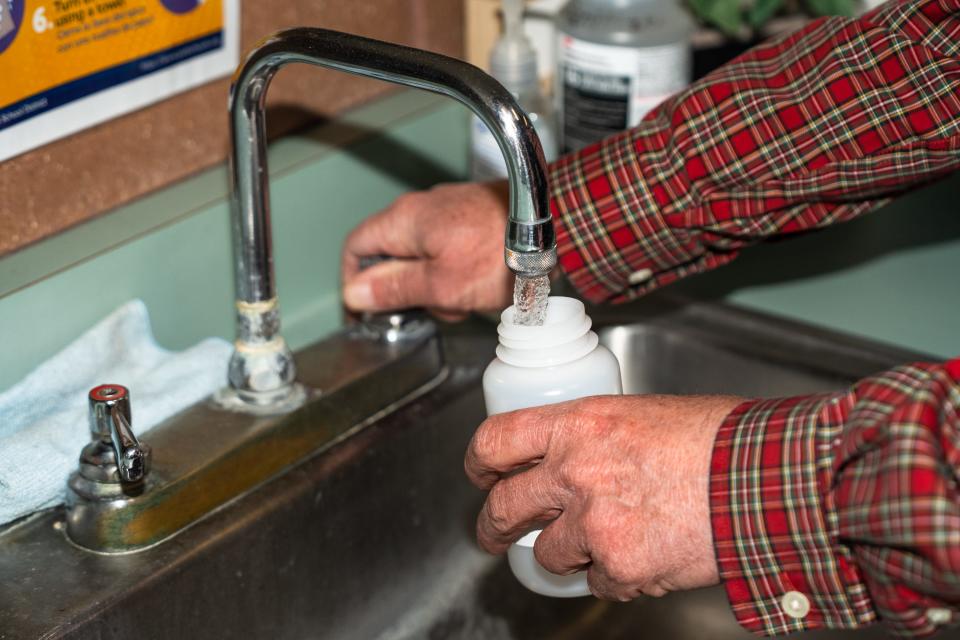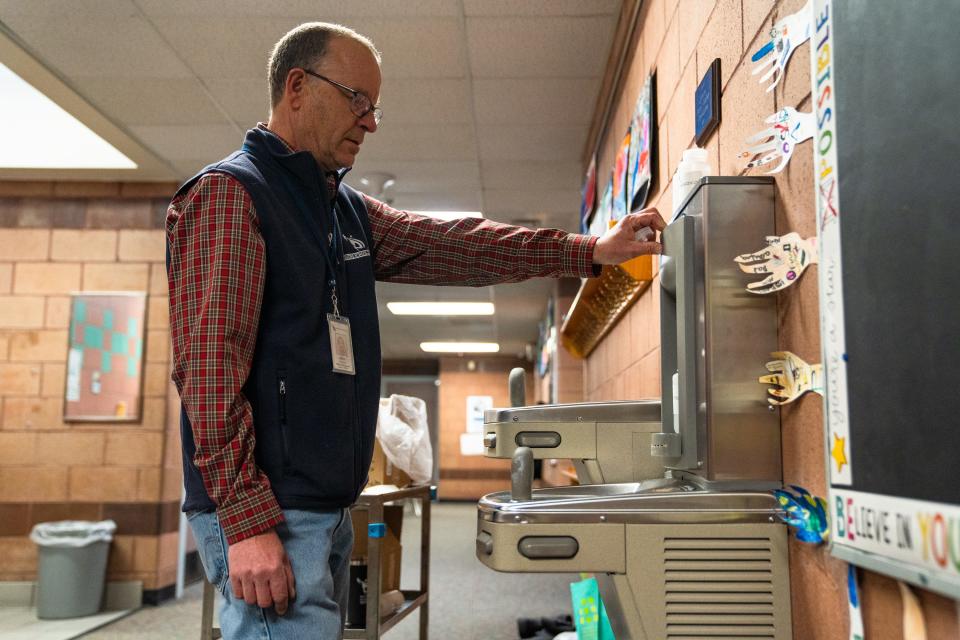Fort Collins-area schools close drinking fountains, replace fixtures to address lead
Poudre School District removed many of the drinking fountains and replaced faucets on dozens of classroom sinks in its elementary schools to ensure the amount of lead in water students drink was within the limits allowed under a new Colorado law.
The classroom drinking fountains are being replaced by hydration stations, where students can fill bottles with filtered water, said John Holcombe, PSD’s environmental coordinator.
“We can filter those, and make sure that water’s good,” Holcombe said Wednesday. “A lot of schools had drinking water fountains in the classroom sink. We just got rid of those drinking fountains. If the faucet failed, we remediated the faucet, but we capped all the drinking fountains.”
Twenty-eight of PSD’s 34 non-charter elementary schools had one or more fixtures that required remediation under the Clean Water in Schools and Child Care Centers legislation that was signed into law in June 2022, according to a Colorado Department of Public Health and Environment database. The law required testing of all fixtures children could drink water from at day care and early childhood centers in the state as well as all public schools serving students in kindergarten through fifth grade by May 31, 2023.
Fixtures found to have water with 5 parts per billion or more when first turned on at the beginning of the day were required to be taken offline until they could be replaced or repaired to meet the standard, which is three times as strict as the Environmental Protection Agency’s “actionable” level for drinking water of 15 parts per billion. There is no safe level of lead in drinking water, according to the EPA.

According to the Centers for Disease Control and Prevention, there's growing evidence that lead exposure can cause cognitive, cardiovascular, immunological and endocrine effects in children. Children younger than age 6 are particularly vulnerable to health impacts due to their developing nervous system.
Statewide, 701 of the 1,546 elementary schools tested had one or more fixtures that tested above the threshold with 3,238 of the 45,486 samples taken requiring remediation. That work has been completed at 414 of those 701 schools, according to the state health department database.
Testing of fixtures in public schools for students in grades 6-8 must be completed by Nov. 30, 2024. Thompson School District began testing at its middle schools last week, environmental specialist Jess Arnold said Friday. PSD will begin testing at middle schools this week, Holcombe said. No testing is required of drinking water in high schools under the law, but PSD officials have said they plan to include high schools in their testing.
More: Does your child's school have lead in its water? Tracking Colorado's testing results
Remediation work nearly complete at PSD elementary schools
Remediation work has been completed at all but four of the PSD elementary schools with fixtures that tested above the state threshold, Holcombe said. The district was still awaiting results from the state’s testing lab following remediation work last month at nine other schools, he said.
PSD replaced the classroom sink fixtures in 16 classrooms at McGraw Elementary School in August, state records show, and all 16 tested below the threshold afterward.
That’s not always the case, though, Holcombe said. Several of the new fixtures installed in PSD schools tested quite a bit higher for lead content after replacement than before.
In follow-up conversations with the state health department, Holcombe learned that new fixtures need to be “flushed” with running water over several days to reduce the amount of lead that leaches from them during use. So, in subsequent testing, PSD flushed the new fixtures the day before taking the required “first-draw” sample the next morning, and lead concentration rates tested considerably lower.
All 16 of the new fixtures at McGraw, for example, were found to have concentrations of lead below 1 part per billion — state testing doesn’t quantify levels below that — after being flushed before testing, according to the state health department database.
“The water chemistry needs to kind of coat those fixtures, and then they should be good,” Holcombe said. “Now when we put in a new fixture, we have our custodians flush it for at least a week with cold water, then we go back and test it. Even new fixtures have a little bit of lead in the valves.”

Throughout the district, 54 new fixtures had tested below the state threshold as of Thursday, Feb. 15, with results submitted in December and January still pending on several others. Service lines were also replaced on five of those 54 fixtures, state records show.
As a result of that experience, PSD flushed many of the other fixtures that had previously tested above the threshold — including 10 classroom sinks at Beattie Elementary — a day or two before taking new samples and found they easily passed, with lead concentrations often two or three times lower than the original samples taken last winter and spring.
Others were taken apart so the aerators could be cleaned, Holcombe said. The state database shows at least 20 fixtures in PSD schools that were successfully remediated that way, including nine at Laurel Elementary.
“The reason a lot failed before is we never removed aerators, and they had gunk in them,” Holcombe said. “We flushed them well the day before we took the sample, because a lot of them that failed were probably never used for days or months at a time. If it sits there for weeks and weeks without being used, a lot of times your first hit has lead in it. But if you flush it the day before, it’s fine.”
Holcombe recommends letting fixtures that haven’t been used in a while run for 10-15 seconds before drawing drinking water from them.
Three of the four schools where remediation work has not yet been completed — Livermore, Red Feather and Shepardson elementaries — are getting new hydration stations that have not yet been installed, he said. Other fixtures requiring work at those schools will be done at the same time, he said, to reduce labor costs associated with multiple trips to the same location by a plumbing contractor.
The district recently dropped the plumbing contractor it had been using because of a rate increase that increased the cost of replacing fixtures well above the state’s $500-per-fixture maximum reimbursement for remediation work, Holcombe said, and has not yet found another to do the work. The district’s own plumbing crew, he said, is short-staffed and too busy responding to more immediate maintenance and repair work at PSD schools to do the replacement work in-house.
The only outstanding remediation work necessary at a fourth school, Beattie Elementary, is on a kitchen kettle that was rarely, if ever, used before it was taken out of use following the initial round of testing.
Holcombe expects all remediation work at the elementary schools to be completed by the end of this week.
“This should have all been done six months ago, but we didn’t have the people to do it all,” he said.
Thompson School District replaces filters and fixtures
Twenty of the 28 schools tested in Thompson School District had one or more fixture requiring remediation, with 72 of the district’s 1,276 samples testing above the state’s 5 ppb threshold, according to the state database.
The district replaced filters on 11 fixtures and both faucets and plumbing service lines on 12 fixtures that had tested above the threshold last spring to bring those fixtures into compliance. It placed signs on 15 other fixtures, including 10 at the now-shuttered Monroe Elementary School, indicating that they should not be used for drinking water.
The sinks with signs designating them not to be used for drinking water were all handwashing sinks in classrooms or kitchen sinks used for washing dishes or produce, Arnold said. The drinking fountain on one dual-purpose classroom sink at Cottonwood Plains Elementary in south Fort Collins was capped during the remediation process.
"We've got multiple fixtures in our classrooms, so we still have a drinking water supply in all of them with either a drinking fountain bubbler or water-bottle filler station," she said. "Our drinking fountains aren't the issue; it's the hand sinks."
Six other fixtures that had previously had levels above the threshold tested below in retesting this fall after cleaning aerators, replacing fixtures and plumbing service lines or simply cleaning them out through flushing, as the state recommended, she said. The district is still awaiting results of "confirmation testing" following remediation work on 18 fixtures that remain off limits for drinking water.
A contractor performed the replacement and remediation work over a two-day period in October, Arnold said, when water could be turned off in the buildings while the work was performed. Confirmation samples were taken in November and December and sent to the state health department's lab for analysis.
Delays in finding a contractor to do the work, as well as ordering and receiving the replacement fixtures, took longer than expected, she said. And results of samples sent to the state are taking three to four weeks or more to receive.
"It's been kind of a challenge," she said. "Everybody wanted to have this done last year, but we're still working on it."
Weld RE-4 removes access, plans ‘long-term fixes’
Weld RE-4 schools removed access for drinking at the 21 fixtures among 342 tested at its elementary schools found to be above the state threshold in May, a district spokesperson said Thursday. That included nine fixtures at Mountain View Elementary, four at Skyview Elementary and eight at Tozer Primary School.
Long-term permanent fixes are planned, district officials said on a lead-testing page on the Weld RE-4 website.
All fixtures tested below the state threshold at the district’s other two elementary schools, Range View and Grandview.
Reporter Kelly Lyell covers education, breaking news, some sports and other topics of interest for the Coloradoan. Contact him at kellylyell@coloradoan.com, twitter.com/KellyLyell or facebook.com/KellyLyell.news.
This article originally appeared on Fort Collins Coloradoan: Fort Collins, Loveland schools work to reduce lead in drinking water

